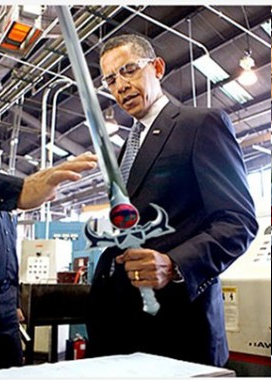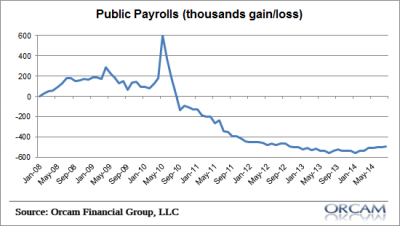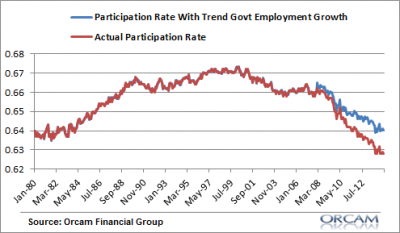One point that doesn’t get a lot of airtime in current economic discussions is just how much the US government has cut back on its worforce in recent years. Government employees are still off by 491,000 since the start of 2008.
This is an unprecedented cut in total government employees. No President in the post-war era has presided over two terms in which government employment declined through his Presidency. Not Reagan, not Bush, no one. In general, they were all huge expanders of government employment.
What’s interesting about all of this is the labor force participation rate which is often cited as a sign of structural weakness in the US economy. Which is true to some degree. But how much of this decline in the participation rate is due to the government job cuts since 2008?
I went back and ran the figures and added in the trend growth in government employment since 1950. Rather than cutting half a million jobs since 2008 the US government would have added about 2.4 million jobs. In this scenario the labor force participation is 64% vs today’s actual rate of 62.8%. Since the rate peaked at 67.3% it’s declined by 4.5 points. In other words, the government’s job cuts have accounted for 27% of the decline in the labor force participation rate. And who knows how much all of that lost input and income could have further multiplied growth and employment….
Mr. Roche is the Founder and Chief Investment Officer of Discipline Funds.Discipline Funds is a low fee financial advisory firm with a focus on helping people be more disciplined with their finances.
He is also the author of Pragmatic Capitalism: What Every Investor Needs to Understand About Money and Finance, Understanding the Modern Monetary System and Understanding Modern Portfolio Construction.




Shervin
What exactly would these extra 2.4m new government employees do? If it’s unproductive work, it will be inflationary.
gbgasser
What did they do during the Reagan years or Bush years when the expansions in govt employment were consistent?
What do they ever do?
The point Cullne is making is that these lost income streams made 480,000 people less likely and able to buy already produced goods, driving down sales and producing layoffs.
Your asking the wrong question Shervin. The people who do work have plenty of productive capacity to create more than we currently are.
jswede
What? Why would these 491k job cuts ALL also leave the Labor Force when they were let go? Do you have any evidence or are you confusing Labor Force Participation with Unemployment?
Cullen Roche
Yes, I had to make some assumptions, which may or may not have turned out to be right….No one can really know.
Cullen Roche
Well, most of them were local and state govt workers like firefighters, teachers, etc. They weren’t fired because they were unproductive. They were fired because the state budgets couldn’t afford them….
John Daschbach
Cullen, the wording you use is not precise and potentially confuses the issue. The figure is total government employment not Federal Government employment. Federal Government employment was 2738 thousand in Jan 2008 and it’s 2717 thousand in Aug 2014, a change of 24,000 jobs. State and local government employment, excluding education has decreased 126,000 jobs. The biggest change is in local education employment which has decreased by 251,000 jobs over the same period.
It appears that the largest contribution to direct employment loss is in local education. Anecdotally this may have also contributed to a reduction in labor force participation, as I personally know of at least 8 teachers who retired (some early, and all in their very early 50’s) when class sizes increased and work loads went to the 60 hour/week range. But as local education is primarily funded from property taxes there isn’t much the President can do about that.
Not captured in the data is the loss is employment due to the reduction in Federal discretionary spending, much of which takes place through contractor employees not counted in Federal Government employees. Looking just at Federal R&D spending (defense and non-defense) it has decreased by ca. $42 Billion. If you figure that half of that is labor (including indirect through domestic procurement etc.) then at $100,000/person fully burdened rate there is another 210,000 job losses due to Federal Government cutbacks.
Reagan followed what I would consider classic Keynesian policy. He cut taxes and increased government spending, primarily on defense (which has one of the highest employment multipliers known). As a share of GDP, defense spending (primarily R&D and manufacturing) increased by 50%. (from ca. 0.55% to 0.85%). As we know, the deficit exploded, inflation and interest rates came down, and unemployment fell. He did exactly what New Keynesians today primarily recommend, even conservative ones like John B. Taylor and John Cochrane.
But today’s radical right has developed a love for Austrian Economics.
Shervin
ok thanks for clarifying because I thought this was just Federal government employees. In this case it appears some of the job cuts were necessary because local and state governments can go bankrupt if they don’t get their fiscal house in order.
Cullen Roche
I used the words “total government employment”. You can interpret that however you want, but in my world it means feds, state and local….
John Daschbach
I understand. But when the job losses have a large local education component there isn’t much that directly relates to something the President has much ability to impact.
Cullen Roche
It’s a bit reminiscent of Europe. It’s not that the govt can’t “afford” to employ these people. It’s that the Federal govt CHOOSES not to provide the funding that would allow the states and local govt’s to continue paying them. The states have balanced budget amendments and inherent trade imbalances. If there were no federal funding for states half of the southeastern states (who are trade deficit states) would go bankrupt every 25 years. The fact that we allow states to fire perfectly necessary employees like the ones educating our children is really a shame in my opinion.
jswede
your assumptions go on to be that the 2.4mil hypothetical gov’t hires all come from OUTSIDE the LABOR FORCE… every last one being hired would be coming out of retirement perhaps?
I think you are confusing LF with Employed… LF is those with jobs *AND* those looking; ie those counted in the headline UE Rate.
Point is the effect on the LFP rate would never, ever happen – even remotely – in the way that you describe.
All the best
Cullen Roche
No, my assumption is that, if these people hadn’t been fired, they definitely wouldn’t have LEFT the labor force. Of course, we don’t know the specifics, but we definitely know that the LFPR would be higher if the govt hadn’t fired the equivalent of 3 million people in the last 6 years….
John Daschbach
But Cullen, doesn’t the Kalecki argument come into play here? Kalecki cogently argued that a Federal Government with a fiat currency could employ everyone who needed a job but the reason they don’t is unemployment creates political power.
Now we have an extreme radical right wing that is driven by an obsessive hatred of government and workers. If the government helped people, as it can easily do, the fallacy of the radical right would be exposed and the political power of that movement weakened.
Nowhere is this desire to have people suffer more evident than in Medicaid expansion. States with GOP governors who don’t expand are explicitly declaring that they want people to suffer, both through limiting health care for the poor AND by the relative tax impact which has all of their citizens subsidizing health care for states which expand.
Cullen Roche
Yep. Here’s how Kalecki phrased it:
“The reasons for the opposition of the ‘industrial leaders’ to full employment achieved by government spending may be subdivided into three categories: (i) dislike of government interference in the problem of employment as such; (ii) dislike of the direction of government spending (public investment and subsidizing consumption); (iii) dislike of the social and political changes resulting from the maintenance of full employment. We shall examine each of these three categories of objections to the government expansion policy in detail.”
https://mrzine.monthlyreview.org/2010/kalecki220510.html
John Daschbach
No. Defense spending has often been a huge economic stimulant, from the Union in the Civil War, to WWII, to the Reagan defense build up. Defense spending is almost purely non-productive. It consumes huge amounts of real resources (steel, chemicals, …) which are then not available for productive output and employs lots of people to do non-productive work. Historically this is often inflationary for the losing side in conflicts, but many factors play into this.
Especially in the current technological era defense spending has a real investment component. Many of the underlying technologies in an iPhone (Internet, wireless systems, GPS, voice activation, touch-screen display, ..) are defense spending originated.
Most new classes of drugs originate in NIH funded research. But as in all research, most effort results only in publications and not eventually a real product. Technically, the majority of NIH funded research is non-productive.
jswede
but you point to zero evidence any of them actually DID leave the LF… maybe 0.1% did..? maybe 1%, maybe 10%? At what point does that number back your title? In your piece, you assume that ALL did, and then you say “well, I had to make some assumptions”…?
further, the ‘hypothetical’ hiring of 2.4mil people could also all have come from within the LF, so it could have had no significant effect on the LFP rate…
Point is that we don’t know, and you don’t provide any evidence at all. I happen to think the effect was (and would be) insignificant, so I take issue with your title – it draws a conclusion from absolutely no facts.
I agree with you on 90% of what you post and see your point – even if I disagree – on 99+% of what you write. I’m not used to seeing something like this on your site. I post this bc I care, not to be difficult.
Cullen Roche
You make nothing but valid points. This post is pure conjecture. It’s pure assumptions. We don’t know if the govt would have hired 10 million people. We don’t know where those people would have come from. We don’t know any of those things. I just used a very basic trend line growth assumption and assumed that those workers would not come from the private sector.
If the govt had hired a lot of workers in this period the LFPR would be higher than 64% in all likelihood. If not, it would have been lower. But we know, for a fact, that the LFPR is lower than it would be if the govt weren’t firing workers. I think that’s a pretty safe assumption given the 3 million person gap in what is and what could have been…..
Robert Buttons
Does anybody truly believe “If only we had more porn surfing govt employees, growth would be terrific!”
Cullen Roche
Let’s be a bit more practical and fair here. All govt employees are not just surfing porn on the internet. The implication that all govt employees are waste is just a bunch of ideological nonsense. You know it’s not true so why promote such an obviously erroneous view?
I respect and agree with your skepticism of govt, but when we go as far to the opposite extreme as the views we oppose then we don’t do the conversation much help….
Robert Buttons
Marginal value theory. Even govts are smart enough to know that if there are to be layoffs, it should be the least productive positions that are cut. I am sure many more “porn surfing slackers” were fired than “Public admin super champions”
Cullen Roche
The labor department said two thirds of the govt job cuts were in education. Do you really think we are lacking in educators in this country? American children are falling behind in most categories. Even a marginally valuable teacher is better than no teaching….I am sorry, but your point doesn’t hold up to the facts. It’s just baseless anti-govt nonsense.
Poseidon's Bear
It’s Friday afternoon, so I thought we could turn to the lighter side.
Mr Buttons criticism has some basis:
https://www.washingtonpost.com/blogs/in-the-loop/wp/2014/09/24/congressman-seeks-ban-to-stop-federal-employees-from-watching-porn-all-day/
Needless to say it isn’t the majority.
What was also pretty darn funny was how GDP is calculated, especially the imputations, here is a funny article on that topic:
https://globaleconomicanalysis.blogspot.com/2014/09/sex-drugs-and-gdp-grossly-distorted.html
I mean really, illicit cocaine as a part of GDP??
cheers,
Robert Buttons
1. “Cuts in education” is different from “Cuts of educators”. Please don’t try conflating the two: “[From 1950-2009], teachers’ numbers increased 252 percent, while administrators and other non-teaching staff experienced growth of 702 percent, more than seven times the increase in students.”
2. Judging by the outcome metrics in the below chart, more staff does not equal better outcomes.
3. It is simply false to suggest students that don’t have a marginal teacher inflicted upon them receive NO teacher.
4. American children are falling behind, but its in horrible, horrible schools, administered by governments. Washington DC schools, for example, spend > $25,000 per student year and the results are some of the worst in the country. Will more administrators help them?
https://charts.stocktwits.net/production/original_15053768.png?1375920681
Cullen Roche
Okay, fair enough. I don’t want to get into a conversation about the quality of American education. So let’s get back on point.
You’re trying to argue that there aren’t productive jobs that govt employees could do. In other words, that our govt needs to be much smaller than it is. In essence, you’re saying the capitalists are the only people who can pick which jobs are worth doing and if they won’t do it then those jobs shouldn’t be done. Never mind that millions of capitalists rely on govt contracts to do work….
I just don’t buy this line that there isn’t productive work to be done that could be done by competent govt employees.
Robert Buttons
A job is not a job.
My Macedonian pal lived under communism. He had a job at a government chair factory. They made chairs, but didn’t sell very many. The extras were taken across the street to the warehouse. When that warehouse filled up, they built another. What’s not to like? The factory kept unemployment low and GDP high.
Under your (govt job) = (private sector job) model, we could and SHOULD hire people to dig holes and fill them in.
That’s exactly why blind allegiance to phony economic aggregates (GDP, unemployment) is so dangerous.
Second, you assume all workers are equivalent. Assume a productive govt worker is fired, they are likely to be at least as productive in the private sector. Net productivity is unchanged. When an unproductive worker is fired and doesn’t find a new job, net productivity is not changed (or minimally decreased), while that capital that was forcibly extracted from my business (taxes) is now returned to the private sector for productive use.
Cullen Roche
That’s just a total misrepresentation of what I said. I did not say we should dig holes and fill them up. I did not say govt jobs = pvt sector jobs. You literally just made that up so you could intentionally misrepresent my argument to make your inaccurate argument look better. Why bother commenting if you have to misrepresent what other people say in order to make your comments look credible???
I said there is productive work to be done today that private sector firms aren’t doing.
If you are going to misrepresent my words in order to make some political argument then don’t waste time commenting. Everyone here can see that your argument is basically politics masquerading as facts. It’s ideological nonsense. Sorry, but you’re not convincing anyone. It’s just pure politics and I am tired of seeing a weak economy and endless suffering just because ideologies like yourself can’t admit that the govt does a lot of good for people and could do a lot more.